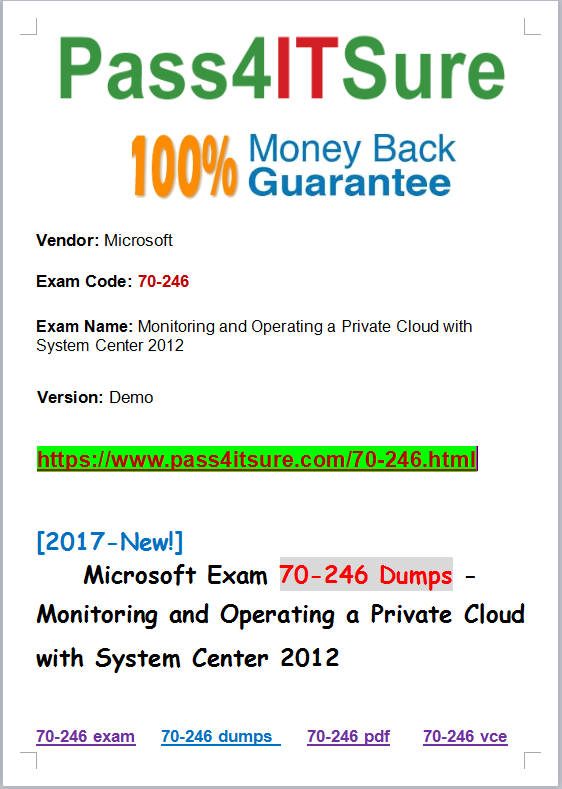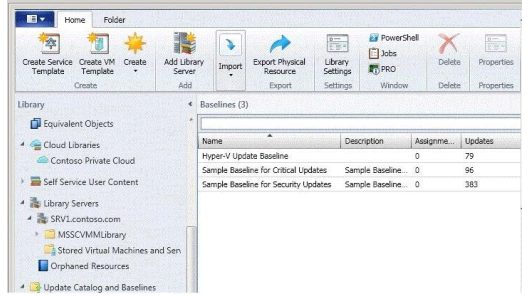[2017 Microsoft Dumps Video] Discount Microsoft MCSE 70-246 Dumps PDF Exam Microsoft System Center 2012 Private Cloud With 100% Pass Rate Is Your Best Choice
Is that true Microsoft 70-246 dumps?”Monitoring and Operating a Private Cloud with System Center 2012” also known as 70-246 exam, is a Microsoft certification which covers all the knowledge points of the real Microsoft exam. Discount Microsoft MCSE 70-246 dumps pdf exam Microsoft System Center 2012 Private Cloud with 100% pass rate is your best choice. Pass4itsure Microsoft 70-246 dumps exam questions answers are updated (153 Q&As) are verified by experts.
The associated certifications of 70-246 dumps is MCSE. The Microsoft https://www.pass4itsure.com/70-246.html dumps covers all the exam topics and objectives and will prepare you for success quickly and efficiently.
Exam Code: 70-246
Exam Name: Monitoring and Operating a Private Cloud with System Center 2012
Q&As: 153
[2017 Other Microsoft 70-331 Dumps Video From Google Drive]: https://drive.google.com/open?id=0BwxjZr-ZDwwWX2NfdW10MUk1MHM
[2017 Other Microsoft 070-489 Dumps Video From Google Drive]: https://drive.google.com/open?id=0BwxjZr-ZDwwWMVJwQXUxZ0JQV28

Following Microsoft 70-246 Dumps 153QAs Are All New Published By Pass4itsure
Question: 1
Your company has a private cloud that is managed by using a System Center 2012 Virtual Machine Manager (VMM) infrastructure. You create a host group named HostGroup1. You move several Hyper-V hosts to HostGroup1. You plan to manage Windows updates for the hosts in HostGroup1 by using VMM. An administrator creates a baseline as shown in the exhibit. (Click the Exhibit button.)

You discover that the updates defined in the baseline are not applied to the hosts in HostGroup1. You need to ensure that the required updates are deployed to the hosts in HostGroup1. What should you do?
A. Copy the required updates to the VMM library server.
B. Synchronize the Windows Server Update Services (WSUS) server.
C. Modify the properties of HostGroup1.
D. Modify the properties of the baseline.
70-246 exam Answer: D
Explanation:
You can see from the exhibit, the baseline the administrator created is not applied. To apply a baseline, you modify the properties of the baseline to select the hosts and groups. Source information: How to Configure Update Baselines in VMM VMM provides two sample built-in updates baselines that you can use to apply security updates and critical updates to the computers in your VMM environment. Before you can use a baseline, you must assign it to host groups, host clusters, or individual managed computers. The following procedure explains how to assign computers to the sample security baseline. To assign computers to a built-in update baseline Open the Library workspace. On the Library pane, expand Update Catalog and Baselines, and then click Update Baselines. The Baselines pane displays the two built-in baselines: Sample Baseline for Security Updates and
Sample Baseline for Critical Updates. On the Baselines pane, click Sample Baseline for Security Updates. On the Home page, in the Properties group, click Properties. The Properties dialog box for the Sample Baseline for Security Updates opens. Note On the left of the dialog box, click Updates to open the Updates page. On the Updates page, optionally add or remove update baselines from the baselines that are listed. The Sample Baseline for Security Updates includes all security updates. To ensure that all security
updates are remediated, do not remove any baselines. Click Assignment Scope to open the Assignment Scope page and then, select host groups, host clusters, and computers to add to the baseline. Computers are represented by the roles they perform in VMM. When you select a role, such as VMM server, all the roles that the computer performs in VMM are selected. For example, if your VMM management server is also a library server, selecting your VMM management server under VMM Server causes the same computer under Library Servers to be selected. To apply a baseline to all hosts, select the All Hosts root host group. Click OK to save your changes.
Question: 2
Your company has a private cloud that is managed by using a System Center 2012 infrastructure. The Service Manager management server is installed on a server named Server1. The Configuration Manager site server is installed on a server named Server2. You create a baseline and several configuration items. You need to configure Service Manager to create incidents for each Service Manager configuration item that is non-complaint with the baseline. What should you create?
A. a task and a Desired Configuration Management Event Workflow
B. a channel and a subscription
C. a connector and a Desired Configuration Management Event Workflow
D. a subscription, a connector, and a task
Answer: C
Explanation:
A connector is required to bring data from Configuration Manager into Service Manager. From there, you create a Desired Configuration management Event Workflow. Using Connectors to Import Data into System Center 2012 – Service Manager
Question: 3
Your company has a private cloud that is managed by using a System Center 2012 infrastructure. The network contains 50 virtual machines that run Windows 7. Each virtual machine has an application named Appl.exe installed. A new version of Appl.exe is released. You need to identify which virtual machines have the outdated version of App1.exe installed. What should you do?
A. From Operations Manager, create a monitor.
B. From Configuration Manager, deploy a Desired Configuration Management baseline.
C. From Service Manager, create a Virtual Machine Manager (VMM) connector.
D. From Virtual Machine Manager (VMM), deploy a service template.
70-246 dumps Answer: B
Explanation:
Desired configuration management in Configuration Manager 2007 allows you to assess the compliance of computers with regard to a number of configurations, such as whether the correct Microsoft Windows operating system versions are installed and configured appropriately, whether all required applications are installed and configured correctly, whether optional applications are configured appropriately, and whether prohibited applications are installed. Additionally, you can check for compliance with software updates and security settings.
Question: 4
Your company has a private cloud that is managed by using a System Center 2012 infrastructure. You deploy Data Protection Manager (DPM) to a server named DPM1. A server named Server1 has the Hyper-V server role installed and hosts a virtual machine named VM1. From DPM1, you perform a full backup of Server1. You discover that you are unable to restore individual files from VM1. You need to ensure that you can restore individual files from VM1 by using the DPM Administrator console. What should you do first?
A. On VM1, install Windows Server Backup.
B. On DPM1, attach the VHD of VM1.
C. On DPM1, install the Hyper-V server role.
D. On VM1, install the integration features.
Answer: C
Explanation:
In either case, DPM utilizes the Hyper-V VSS writer to synchronize block-level differences within the VHDs using a process called an “Express Full”, which identifies which blocks have changed in the entire VHD and then sends just the updated blocks or fragments. This provides a complete and consistent image of the virtual hard disk files on the DPM server or appliance. DPM maintains up to 512 shadow copies of the full VHD set by storing only the block-level differences between any two images.
The 70-246 dumps exam is very challenging, but with our 70-246 questions and answers practice exam, you can feel confident in obtaining your success on the 70-246 exam on your first try! The https://www.pass4itsure.com/70-246.html dumps exam is written and formatted by Certified Senior IT Professionals working in today’s prospering companies and data centers all over the world!